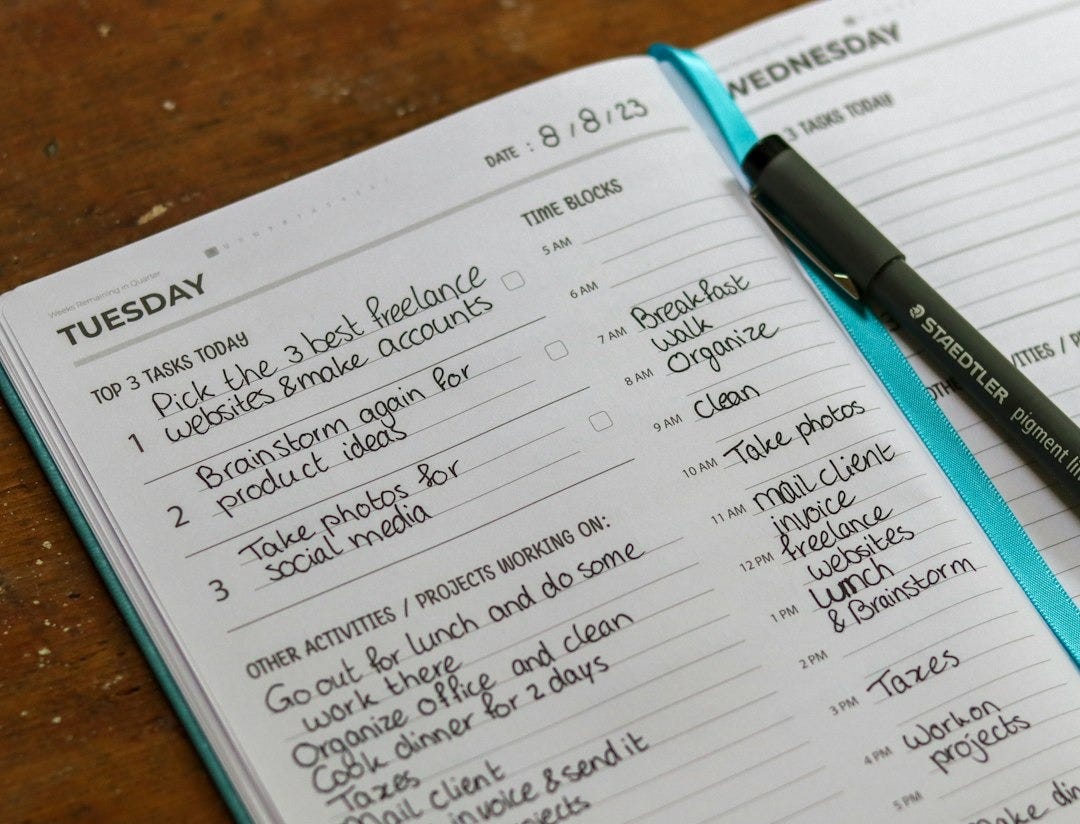How to Find Time For Substack While Working a Full Time Job
Let's talk time management

Want to know what’s frustrating? Wanting to grow your Substack, while having to work a full-time job. You’re already exhausted, then you feel guilty for not doing more.
Then on top of that, being told by Substack experts that you need to ‘put in the work to get the results you want’.
What you really need is another 10 hours in the day. And less judgment from the writers who are in a position to devote that 10 hours a day to growing their Substack.
So if you want to grow your Substack, but are limited to nights and weekends due to your full-time job, then what are your options?
What Are You Even Doing Here?
First, let’s figure out what your long-term strategy is for Substack. Assuming you are interested in making money from Substack, to what end? Basically, you need to decide what outcome you want to see.
Do you want to eventually have Substack become your main source of income? Or do you want to develop it into a ‘side-hustle’ that compliments your income from your job? Or are you only looking at using money you make from Substack to fund a particular purchase?
If your goal is just vacation money, your strategy looks different than escape-your-job money. Which is why you need to design a strategy around your needs.
Did your eyes just glaze over? Look, designing a strategy to guide your efforts is sound advice. If you are strapped for time, the first thing you need is a plan that’s going to make good use of every spare minute you have.
Obviously, you have to be insanely efficient with your time management.
Start by reading this framework I shared last week with Paid subscribers:
Own Who You Are, Own What You Do
Last week, we talked about the importance of projecting authority and owning your qualifications to your audience. This week, I want to do a deep dive into how to position yourself so that you project authority to others, while also bringing clarity to your branding and work. Paid subscribers will have access to the entire article.
This will help you bring clarity to your positioning. Once you have defined who you are and what you do, it becomes far easier to attract the ‘right’ people. Which in your case are the people who will pay for your content.
And in less time. We love anything that’s going to result in you spending less time on a task.
Here’s an example of how a solid strategy can save you time. Let’s say your goal for your Substack is to have it generate $100 income a month.
You are charging $5 a month for a Paid subscription. You currently have 10 Paid subscribers, so your monthly income is $50. You are halfway to your goal right now.
Your conversion rate is 1%. That means you have 1,000 subscribers, and 10 of them are Paid.
But…if you could increase your conversion rate from 1% to 2%, then you would hit your $100 income goal. So you actually have enough subscribers on hand now to hit your income goal.
You don’t need more subscribers, you need to do a better job of converting the ones you have from free to paid.
That’s where a solid conversion strategy comes into place. I’m not going to get into that topic in this post, but be warned that starting next month, we are going all in on boosting your conversion rate. Stay tuned for more info on that.
To Write, or To Engage…That is the Question
The two main activities you will need to devote time to is creating content, and interacting with the current and potential consumers of your content.
Writing - I would advise you to shoot for one article a week, no more. And don’t try to publish a thesis, I would cap it at 1,000 words. If you can only do 500 words, that’s fine. Let your schedule be your guide.
As for when to write, that depends on your schedule. I would set aside a minimum of one hour to write. Personally, I need at least 2 hours a post, often 4 hours. Sometimes much more. But if you are focused on 500-1,000 words, that should take a bit less time.
I would use AI tools like ChatGPT and Claude to help you come up with ideas for posts, as well as help you structure and edit your posts. This will make your posts more readable, and will also save you a bit of time.
Engagement - When your time is limited, I believe engagement is even more important than writing. And you want to consistently engage.
My advice would be try to set aside at least 15 minutes a day after work for engagement. Start by checking your notifications, reply to anyone who has interacted with you via comments. If you have any time left, then go read some of the pubs you are subscribed to, and try to leave a comment and/or restack. If you can do 30 minutes a day, even better.
In my view, it is better for you to engage 15 minutes a day for 4 days in a row, than it is to set aside an hour a week to engage and only show up once a week here. It’s better for you to be active 4 days vs 1, even if the length of that activity is only 15 minutes a day.
Also more ideas on engagement here:
The Elephant in the Room
You have to actually show up. This is another reason why I recommend engaging for 15 mins a day for 4 days vs just showing up once a week.
You can grow your Substack on the side IF you are willing to commit to it. Set realistic goals and design a strategy and time management plan that you can live with.
You don’t need 10 more hours. You just need the right system.
What’s your biggest Substack time sink? The area you need help with the most?
Mack
Backstage Pass teaches you how to better connect with your customers, readers, clients, or donors. The lessons shared here draw on my experience over the last 20 years building customer engagement strategies for companies like Adobe, Dell, Club Med, Ingersoll-Rand, and countless others. I give you real-world research, examples and tactics that show you how to create customer engagement efforts that drive real business growth.
The ‘Experts’ Lied to Us
For over 20 years, I've worked with Fortune 500 companies and startups to help them build better customer engagement, acquisition and retention strategies. Every issue of Backstage Pass pulls back the curtain and shares what I've learned, and teaches you how to apply these same concepts to grow your own Substack into a sustainable business.




It’s helpful to be reminded that consistent small steps, like 15 minutes of engagement a day, can matter more than big bursts. Makes the whole thing feel more doable. Thanks, Mack!
After getting the bills pay, it’s all about bumping into new and old friends, and struggle together like it’s a party.